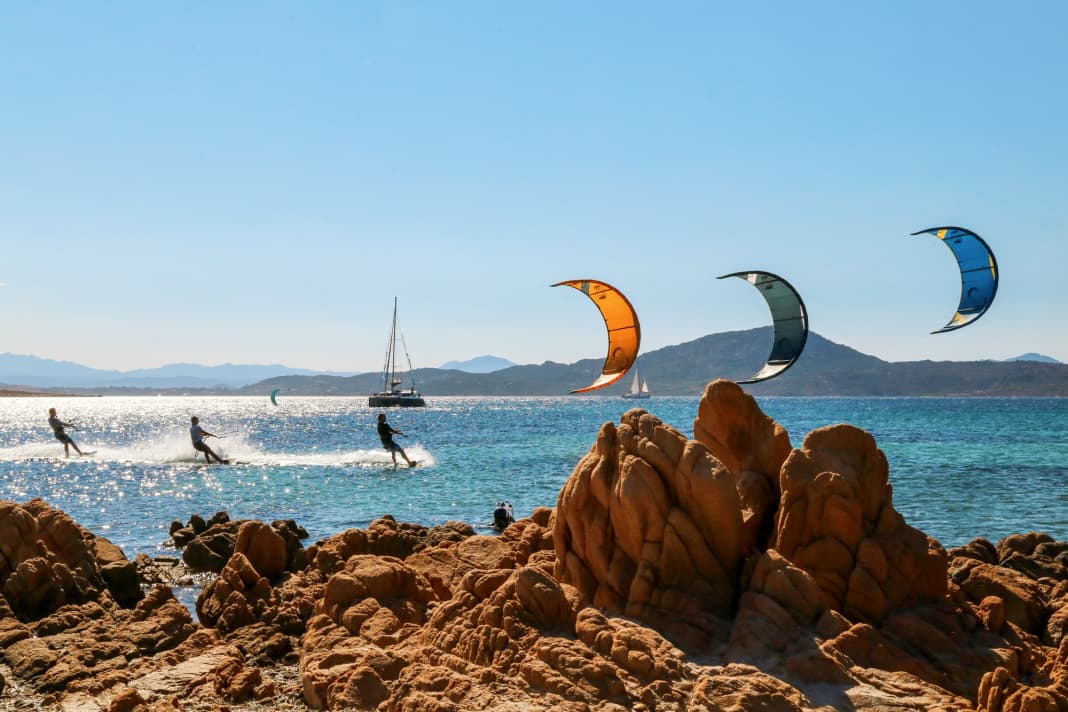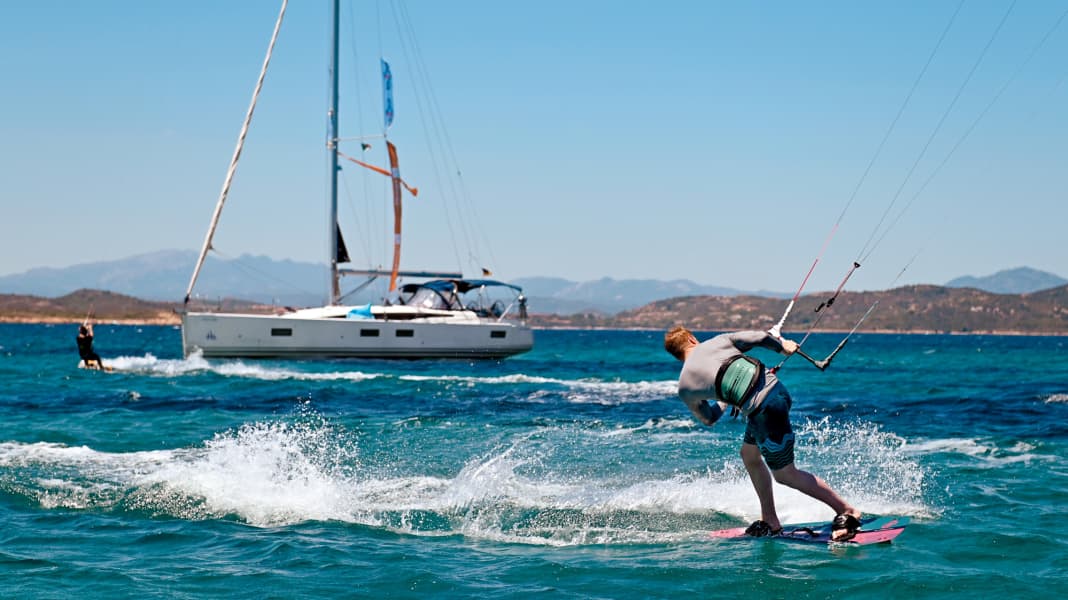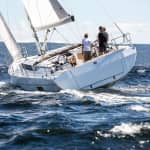In this article:
If I didn't know that these guys are all top athletes, I'd think they were smoking something. "You have to hook the chicken loop first!" they say. "At the bar, practice with feeling, always stay in the sine curve," explains another. "And practise the body drag first, otherwise you'll have to walk the walk of shame." Aha!
The group in the cockpit of the "Kite Voyager", the mother ship of the "Kite-2-Sail" flotilla, grins and continues to text me with scene jargon. I only understand what he's saying. We are sitting over a welcome beer in the picturesque Marina dell'Isola in the north of Sardinia. As a sailor with no kitesurfing experience, I have tried to elicit from Sören, Jan, Arne and Philipp what is important in their sport and what I need to know as a beginner.
Lesson one has already been learnt: kiters speak the same technical jargon as sailors, it just sounds hipper. Logo, it's also a modern trend sport that is booming like crazy. And it has caught on with a surprising number of sailors. Even Boris Herrmann is a fanatical kiter and Alex Thomson is one anyway, as everyone knows after his Skywalk stunt - just google it! - know. Even among my fellow sailors over 50, kite fever is rampant. In this age group, it is apparently the legitimate successor to riding a Harley.
Relaxed sailing to the best kite spots
It also makes sense somehow: You need sea and wind for sailing and kiting, so why not combine the two? That's what Marc Rosendahl, until recently co-owner and managing director of a charter company, thought. Without further ado, he founded the "Kite 2 Sail" project. The idea is simple: sailors who also kite sail with like-minded people on a specially equipped catamaran to the best kite spots in Sardinia. Relaxed sailing is the order of the day on the way there. Once you arrive at your destination, you can fly your kite. Sorry: the kite.
Gallery: Combined trips for sailors






And incidentally solves one of the biggest problems that kiters have: "More and more beaches are being closed for kiting. Setting up the equipment takes up a lot of space, and launching in shallow water between bathing beach visitors is not a good idea," explain Marc Rosendahl and kite sales specialist Philipp Mohr from manufacturer Eleveight. After all, the many lines can quickly become dangerous for bystanders.
This first combination trip off Sardinia is intended to test whether the concept works. The professional kiters Sören Cordes and Jan Burgdörfer as well as Arne Schuber from "Kite-Magazin" are also taking part. Simply sail the yacht to beautiful bays and launch directly from the boat in deep water. For this purpose, three inflatable floating platforms are available on the foredeck of the cat, from which the launch is to take place later. The special project cannot be overlooked elsewhere either. In the cockpit, on the foredeck, the trampoline and even on the cabin roof, there is a tangle of ordinary boards with small fins, futuristic-looking foil boards, lines and rucksacks.
Kiting between mega yachts and dream bays
Lesson two: Kitesurfing is at least as equipment-intensive a sport as sailing. You need kites of different sizes, different boards, short and long lines. It takes a while to stow everything away, but then the "Kite Voyager" sets off and steers through the picturesque waters of northern Sardinia.
"The area is ideal for kiters because of the frequent mistral," explains Marc Rosendahl. You can always find a good, or windy, spot here. Between mega yachts and dream bays, we set off for the first stage destination, the island of Tavolara, where the prevailing southerly wind should provide a perfect jet. We head there with a light wind.
Perhaps kiting and sailing really do go very well together.
Marc wants to set a new gennaker that he has brought with him. I put the sheet on and kiter Jan looks over my shoulder. "What exactly are you doing?" he wants to know "I'm rigging the furling line, adjusting the length of the downhaul and barber haul and pulling the sheets through," I reply. "Please what?" he asks, puzzled. We both have to grin. Maybe kiting and sailing really do go very well together.
Gennaker off, kite out
The wind picks up on the way to the bay. Sören and Jan get restless: "It's kiteable with the foil!" So we furl the gennaker, stop, and the boys quickly set up the bar, which is actually just the wide pole that holds the kite to the control lines. "And how are they going to...?", I think to myself as the kite of two-metre man Sören Cordes is already in the air. The chicken loop, the safety device on the harness, is hooked in. Sören goes to the bathing platform, simply throws the board with the foil underneath into the water and jumps in after it. Feet on it, the kite pulls him up - and he's off. The whole thing takes less than five seconds.
He then whizzes round the boat high above the water at breakneck speed. It looks playful and very cool. How does he do it in the measly ten knots of wind? Kiter Jan grins. "He flies sine curves. Or low figure eights. This gives the kite more pressure." The principle of apparent wind. Sailors know this from fast, planing boats. Cool!
Sardinia's Costa Smeralda is the dream setting for the cruise. The frequent mistral brings constant wind
On board, we set the gennaker again and the kiter and cat sail together to the island of Tavolara. The three huge inflatable floating pontoons are used at the anchorage. They are lashed next to each other at the stern so that the kiters have a sufficiently large area to prepare their kites and launch them from there. "That works great!" says kite pro Jan approvingly. But launching from the platform into deep water is probably not for beginners. Anyone who goes on these trips in future should therefore be able to kite.
The atmosphere on board is reminiscent of a student flat share
The wind falls asleep in the early evening. Marc's wife Marcella conjures up original Italian pasta in the galley. The crew had organised the ingredients; the trip is designed for self-catering. The atmosphere on board is great, it feels a bit like a student flat share. Later, the kiters are pulled around the boat on the foil by the 40 hp safety rib. Great fun!
The next day brings good winds. For kiters, this means well over 15 knots. The boys get jittery. Sören, Jan, Philipp and Arne get their equipment together, launch the kites and head out onto the water. An unrivalled flying show begins. Eleveight factory rider Jan Burgdörfer, "Rider of the Year 2021", gets going. He jets towards the cat at full speed, makes an arc to gain momentum - and jumps. The kite pulls him five or six metres into the air, the athlete performs somersaults, pirouettes, lands and keeps on going!
As a sailor, I stand there with my mouth open in amazement.
Sören also comes flying in at full throttle, jumps off, passes somewhere at saling height, briefly takes the board off - show act. It gets crazier and crazier. As a sailor, I stand there with my mouth open in amazement. So that's what this kiting is all about. The guys are in a frenzy, only come on board for short breaks to catch their breath, shove a sandwich in, then it's on with the show. We sailing normals on board enjoy the spectacle with a drink in our hands. The first motorboats with curious spectators approach from the anchorages off the beach.
Sailing is just moving to the next spot
As the nearby beach empties in the evening, we move to the shore. Now we realise how much space is needed for kiting. The boys take up half the beach with their equipment as they set up. Shortly afterwards, they glide across the bay in the light of the evening sun as if strung on a string of pearls.
To get a kite ready to launch, you need space. This is in short supply on many beaches, resulting in bans
As a non-kiter, I'm also starting to get jittery. I have to try it once! I nag the boys to give me a crash course. The next day I have them ready.
But first we drop anchor and move on to the next kite spot. Sailing on this trip is more of a shift to the next place with good wind. This also means anchoring in the windier parts of a bay. Unusual for sailors. In this case, we stop in Porto Pollo. On the shore is a mega-long, gleaming white beach with beach clubs and kite schools. In front of it, 100-foot yachts are anchored. The wind weakens a little and the foil boards are used again. At some point, the pros run out of steam and start an Aperol spritz party on the foredeck of the catamaran.
And to finish: beach party!
Philipp relents and gives me a kite lesson. First in the sand on land. Harness on, kite inflated with the air pump, control lines laid out. With the kite downwind, he teaches me how to launch it. I'm surprised at how much power it has. In a gust, it sweeps me off my feet. Then Philipp shows me how to fly turns with the movements of the bar. The pull is actually much stronger the deeper and more extreme the turns become. However, if the pressure becomes too great, you can "park" the kite quite well in the waiting position at the zenith - like luffing and dropping a spinnaker.
After half an hour of practising, stage two follows in belly-deep water. My instructor tells me to let myself fall forwards while continuing to control the kite. It then pulls me forwards and upwards through the water. This body drag works so-so at first, but soon the kite hits the water. To launch it, you have to turn it round again by tugging gently on the lines. Anyone who has ever trimmed a spi will quickly understand this. After three quarters of an hour, I've got the hang of it.
Now I have to learn how to move the kite to the edge of the wind and let it pull me to the side. "That way you can cross later," explains Philipp. "Then you won't have to do the walk of shame," he grins. This means that you haven't made it back against the wind and you have to walk back along the shore with all the kite gear. Got it!
When I finally want to get on the board, the wind dies down. So let's put that off until another day. Enough learning for today. Instead, it's time for a beach party. Another thing that unites kiters and sailors.
Travel information and other combination cruises
Sailing & Kiting
- Kite 2 Sail: The cruise described can be booked as a bunk or full charter of the catamaran with friends. The week costs from 1,790 euros including skipper, safety boat, Wi-Fi, harbour fees and meals. You can bring your own kite equipment or hire it on site for 200 euros per week. The four-cabin catamaran with skipper is available from 11,000 euros per week. Yoga trips with a certified instructor are available on request! Info: WWW.KITE2SAIL.COM
Sailing & Yoga
- Sail with us:Trips off Sardinia (with charter yachts) and in Greece from Athens. Exercises mostly on land with a trained yoga instructor. Self-catering. Group size usually 6 to 7 people. From 1,190 euros. Info: WWW.SAILWITHUS.DE
- Yoga and Sail:Provider with yoga and meditation programmes in southern Europe. Lots of anchoring, few harbours. Exercises on the shore early in the morning or later in the evening. Self-catering. Certified yoga teachers. 6 to 8 participants. Skipper and some crew included. From 1,390 euros per person plus on-board cash. Single berth 50 per cent surcharge. Info: WWW.YOGA-AND-SAIL.DE
- Soul Sailing Crew: Not an organiser, but a platform that brings skippers and crews together and collects a commission for this. Info: WWW.SOUL-SAILING-CREW.COM
Sailing & Biking
- Island hopping:Long-standing provider of cruises, mostly on large traditional Dutch sailing ships because of the bulky bicycles. Travelling in Germany, Holland, Southern Europe and even Scotland. Groups of 20 to 30 people. Price from 1,700 euros incl. half board. Single cabin 50 per cent surcharge. Info: WWW.INSELHUEPFEN.COM
- Ivent Sailing:Tall ships in Germany and the Danish South Sea. Double berth from 880 euros, single berth from 1,300 euros. You can bring your own bike. Info: WWW.IVENT-SAILING.COM
- Bike boat trips: Wadden Sea or inland cruises in the Netherlands on tall ships. From 839 euros. Info: WWW.RADSCHIFFREISEN.DE
Sailing & Climbing
- Alpine worlds: Climbing on the Greek island of Kalymnos with a certified mountain guide. Various levels of difficulty. Price: 1,690 euros per week including half board. Info: WWW.ALPINEWELTEN.DE
Sailing & Diving
The easiest way is often to combine a trip with a visit to a diving centre in the area. Agencies or fleet operators can organise this in many areas. The crew makes an appointment on site and then sails to the dive centre, which provides equipment and a certified dive guide.
Tips for booking combined cruises
- Bunk or whole cabin? Not everyone wants to share a cabin with strangers. However, privacy often costs 50 per cent more.
- Owner's boat or charter yacht? Sometimes the boat is not a standard charter yacht, but possibly an older boat of an owner who is also an instructor/teacher and lives on board.
- Guide/instructor included? For climbing or diving, but also for non-dangerous sports such as yoga, a certified instructor or guide is useful or even necessary.
- Own or hire equipment? Not everyone wants to lug their bike or diving equipment on the plane. Some equipment can be hired locally. Check prices and availability.
- Incidental costs included? The offers often do not include travel. There are also additional costs such as on-board cash, transfers and catering. Are demurrage and fuel included? Be sure to ask, otherwise you could be in for an expensive surprise.
- What language is spoken on board? Not all offers are with a German tour guide, sometimes you should have a basic knowledge of English. Please enquire before booking!
- Are tips customary? For the staff on the cruises (tour guide, instructor, crew), a tip is usually customary for good performance. Organisers recommend at least ten euros per participant and crew member.


